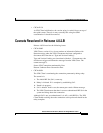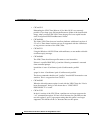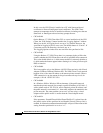
Caveats Resolved in Release 4.0.1
82
Release Notes for VPN Client, Release 4.0 through Release 4.0.5.D
OL-5450-10
• CSCea47454
Buttons in Certificates->Import/Export windows are truncated when using
system Large Fonts (120dpi) setting.
• CSCea76011
IPSec over TCP and/or Split tunneling does not work on certain machines.
This issue is the same as CSCdz51629, and CSCdy80016. For example, using
a Sierra SMC2632W wireless card, and building a VPN tunnel to a PIX
firewall, if split-tunneling is used, then no SAs are built for the networks in
the split tunnel list, resulting in no traffic flow over the tunnel.
• CSCea86293
The VPN Client continually prompts for the password when using the
following command line:
ipsecdialer.exe /c /user USERNAME /pwd PASSWORD PROFILE
• CSCea88456
When installing Release 4.0 of the VPN Client on Japanese Windows 2000,
the virtual adapter installer hangs.
• CSCea93394
This problem occurs only on the Windows version of the Release 4.0 VPN
Client, not on non-Windows platforms or earlier versions of the VPN Client.
When a tunnel is established, the central site Concentrator could send a DNS
domain to be used by the VPN Client by mode configuration. The VPN Client
makes the changes to the system to use the DNS suffix pushed by the
central-site Concentrator. This works fine, but when the tunnel is
disconnected, the DNS suffix change that was made when the tunnel
connected is not undone.
• CSCeb00459
When the Cisco VPN Client disconnects, it logs the following message in a
file called faultlog.txt, located in C:\Program Files\Cisco Systems\VPN 3000
Client:
27 22:50:50.401 04/27/03 Sev=Critical/1 CVPND/0xE3400001
Microsoft IPSec Policy Agent service started successfully
The message appears only when we disconnect the Client. The Client
functions without any problems.


















